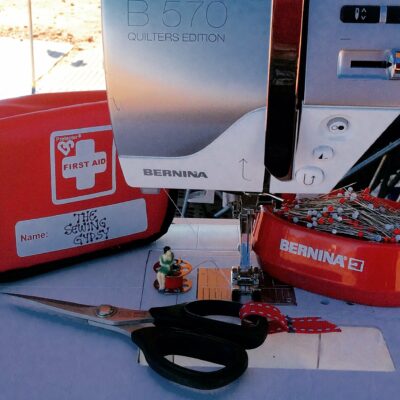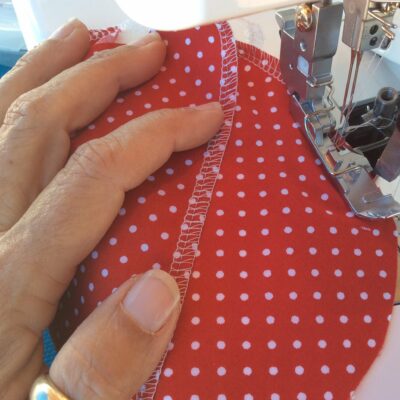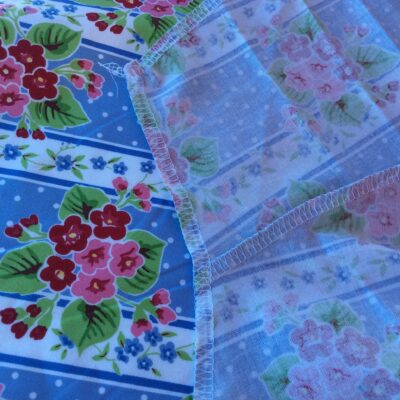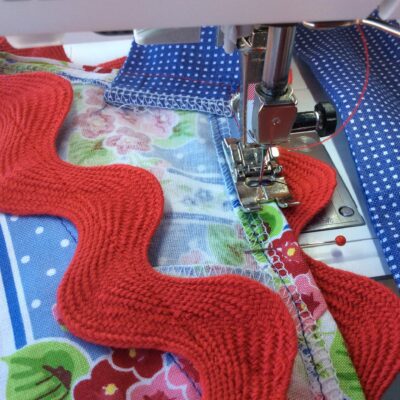Solar Powered Sewing
Have you ever wondered how to sew with your Bernina Sewing Machines, whilst travelling extensively through remote areas, with only the sun to give you power? … Well that is exactly what I am doing here in Australia on an extended adventure of around 16 months. I power my Bernina B570QEE Sewing and Embroidery Machine, and 800DL Overlocker totally on Solar Power!! We have lots of sun here in Australia!! … and … this is for those who may even be ‘Living Off Grid’, relying on Solar Power as well – you CAN still SEW!
We have a Nissan Navara Four Wheel Drive Twin Cab vehicle, and tow a 2013 Kimberley Kamper Platinum Edition behind … our King of the OffRoad!! Both are packed to capacity with all our ‘necessities’ … that is, mostly sewing and fishing gear! We eat fish most days a week (my partner The Fish Whisperer, is a great fisherman!) … and I sew whenever the weather allows me – totally outdoors! We do a lot of National Park camping, and free-camping. There has been the odd occasion where I use power supplied at a Caravan Park, but mostly … it’s Solar. Here I am set up ready to sew at Cleaverville Beach, Western Australia.
Follow along here with me, and I’ll walk you through you my setup … if you are wanting to ‘Sew by Solar’, you will have to check your own supply/setup first as they vary considerably from one manufacturer to another.
Firstly, it’s important to know how much power each of your machines use – my sewing machine draws 100W, my overlocker 105W – both lots of info are on the back plate of the machine. That is how much power they use when they are in operation – if just plugged in, they use a lot less.
Next, is the power supply, we have a 100W Solar Panel, which charges our 6 Batteries stored under the bed, and a 600w Pure Sine Wave Inverter, which in simple terms, mean I can plug in appliances that draw 600w total at any one time. I never use my full size iron by the way – just a little travel one – and that draws 340W!! I do a lot of finger pressing! I also connect only one machine at a time. We have a lot of sun here to charge up our Solar Panel and even when I am sewing all day, I use very little ‘total’ power – that is, more goes back in than what I use – now that’s fabulous – obviously I don’t sew on rainy or very overcast days – they are rare where we are travelling anyway. Regarding the photo below … 13.1V shows the state of charge of my batteries, .6W is how much is drawn when the sewing machine was idle, and 88W is when the machine was at full speed.
So all plugged in now and ready to sew!
It has been weeks since I last sewed anything … and I was eager to make myself a vintage style apron, made my pattern (before I left) from an old one I had back home. We have just travelled over 660km of dirt/gravel roads and corrugations on the Gibb River Road, right through the wild heart of the Kimberley region in Western Australia, from Kununarra to Derby, through a spectacular landscape of intensely coloured ranges, dramatic gorges and lush rock pools and waterfalls, everything the Kimberley is famous for!
My machines were all well packed in the back seat area of the car (which is lockable) and travelled without incident. The Bernina Carry bags are well padded and protected my precious machines. My main ‘box of sewing stuff’ however, didn’t fare as well – red dust through most of it !! Grrrr !! A brush off with my bannister brush and they were all ready to go again … some fabric WILL need washing …
I threaded up the overlocker for the first time since leaving home with my Mettler Metrocor Polyester threads (love good quality overlocking thread – it is often my seam!!) and overlocked the raw edges, seamed the front piece to the side pieces … such a lovely stitch!
I hemmed the top edge of the pockets, and then lengthened my stitch to 5.00 and basted around the curved edges of each pocket … pinned the allowance to the wrong side, pulled up the threads and voila!! A lovely curved edge without pressing! (Remember – I don’t use an iron much!) Stitched the pockets into place with my #1 Foot, using the inside edge of the right hand toe as a guide for stitching.
I made the waist and neck straps, and then hemmed all around the apron. Rick Rack was next … Pinned to the hemmed edge of apron, matching ‘valley’ of trim to edge of fabric, my Little Bernina Gypsy watched on … using the inside edge of the right hand toe as a guide again, and amazingly, ended up right up the middle of the trim on the right side. Magic!
I used my #1 Foot, dropped my Feed Dogs, and chose the Button Sewing Program # 60 to secure each of the outside curves of the Rick Rack – I’d made another like this years ago, and because it was so wide, it tended to ‘flop’ over the edge instead of sitting nicely. Yes, I am very particular when I make anything! You can just see the jump stitch between curves here – thread was a fabulous match!
And here it is finished – a very windy day, so I laid it out on my little portable Sewing Machine table for the photo.
And as the ‘curtain closes’ … here are the Stars of this Post … ‘Bridget’, my Bernina B570QEE (oh, my shy 800DL overlocker was all packed away) … and my Solar Panel! (Brought in out of the sun for the photo …)
I hope this gives you the enthusiasm and sense of adventure … to take your machine on the road, and outdoors … and enjoy some Solar Sewing!
Enjoy the outdoors, as I share my adventures on www.thesewinggypsy.wordpress.com
Rhonda
 BERNINA Corporate Blog -
BERNINA Corporate Blog -





















![IMG_7334[1]](https://blog.bernina.com/en/wp-content/uploads/sites/4/2016/06/IMG_73341-225x300.png)




I use solar power when using my Bernina 750 QE and 1130 on our houseboat. When we are moored in the home base marina at Blanchetown, South Australia, we have access to 240 v power, but once we leave the marina to cruise along the River Murray, our electricity is supplied by solar panel charged batteries which power lights, water pumps, sound and communication systems, laptop computers and sewing machines. I leave the Bernina 1130 on the houseboat so that I only need to take supplies when I visit the houseboat.
As much as I love the idea of sewing in the great outdoors, my machines are far too precious to take them through all that red bulldust, along with the sand and salty air. They would need a good service and clean out when they got home.
In South Africa with our regular power cut, a solar panel is the answer. Thank you for the wonderful tip and the information to get the needed power for our sewing machines.
Hi. This product is definitely needed in the remote rural of Papua New Guinea. I am interested in acquiring one . How to I get one?Kind regards Rita
Dear Rita, sadly the author of this block, the sewinggipsy, is not active on the blog anymore and wont be able to answer your question. You might want to try and contact her on other social media plattforms, or contact solar panel manufacturers yourself. It’s also possible that you need a completely different solution, since it also depends on the setup of your own gear. I hope you will find something!
Kind regards, Ramona from BERNINA International
I am taking to my 3rd cross country(US) journey (what else to do while this covid thing is working itself out)..Anyhow, this article is very helpful. I was just sitting here looking at baby girl clothes patterns and thinking how much I love sewing and wouldn’t it be great to do it on the road. Your blog was the first to pop up and I’m glad. I am installing solar panels and kit and am still trying to understand the whole wattage thing. I need solar 101 and have read numerous articles that lose me about half way in. Is it necessary for me to have 6 batteries? I am traveling in a conversion van and really need the space for other things. Plus now I need to work out space for a little work table/station. Any advice would be most welcomed. PS. The only other thing that will take up much wattage that I am powering is a mini fridge. The rest is stuff that I can put directly in the sun to power if necessary.
I’ve just started researching running sewing machines on solar power. I’m inspired by you and your sewing. After a trip to Zimbabwe teaching girls how to make reusable sanitary hygiene products, I set up a sewing scholarship project to provide students who couldn’t attend the class because their parents couldn’t afford the cost of the fabric. It has been running for 3 years now and very successful. The condition of the hand wheel machines are what nightmares are made of. 90% of their sewing has to be by hand. Thanks to you I now know what to look for on the back of a machine. I need questions like ‘do you need the whole setup with batteries, inverters or can you just put the solar panel out in the sun and start sewing?’ probably a really silly question, I know. They have a lot of sun in Zim. Anyway, you have started me on my research journey. I wish you all the best on your journey. And you do own the best machines, lucky you.
Thank you Leanne for sharing your sewing scholarship story – what a fabulous scheme! Yes, you are thinking correctly … you do need batteries, and an investor to run the machines, cannot ‘plug’ directly into a solar panel. Simply put … the solar panel ‘captures’ the energy, the batteries then store it for future use, and finally the invertor ‘changes’ it into a useable power source for the machines. As I said in my post, we had a 600wt invertor and it performed fabulously. I am now back living in a large city, and using mains power … I have very fond memories of my time on the road, sewing with solar power. I am thrilled that I have been able to give you some info to continue on your ‘solar journey’ as well. I now sew on the lovely new Bernina B590E Sewing and embroidery machine, and also have the great B460 Overlocker as well … yes, I am blessed to have amazing Bernina Machines to sew on and share my experiences with. I wish you every success, and would love to keep in touch.
Hi Again. Can you talk more about the inverter? I’m not sure exactly what is necessary for a mini fridge and sewing machine.
I’ve been wondering how many panels and batteries to get for a home solar sewing system.
Hi Rhonda, really liked your post – very informative and interesting as I use to work for a company selling portable solar. Oh and I know all about the red dust – as a kid we drove across the Nullabor before it was sealed – opened up the back of the station wagon at Port Augusta and it was caked everywhere (much to Mum’s horror). Also love my 570QE and 800DL, interesting to see them out in the wild. Happy Travels.
Thanks Sandy! We are heading across the Nullabor in a few weeks!! Thankfully … now all sealed!! Still getting dust out of my stuff from doing the Gibb River Road! Solar sewing is fab fun!!